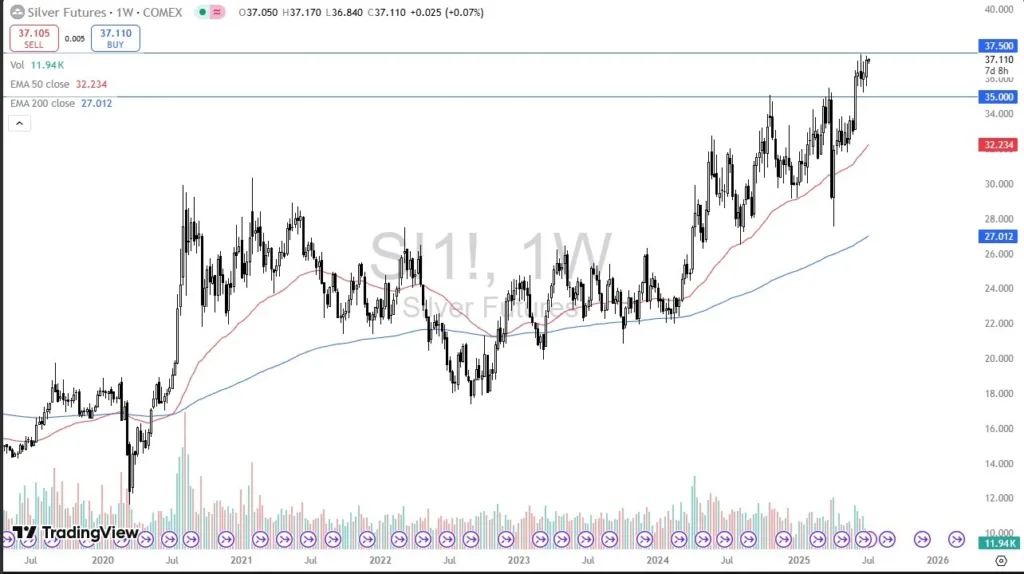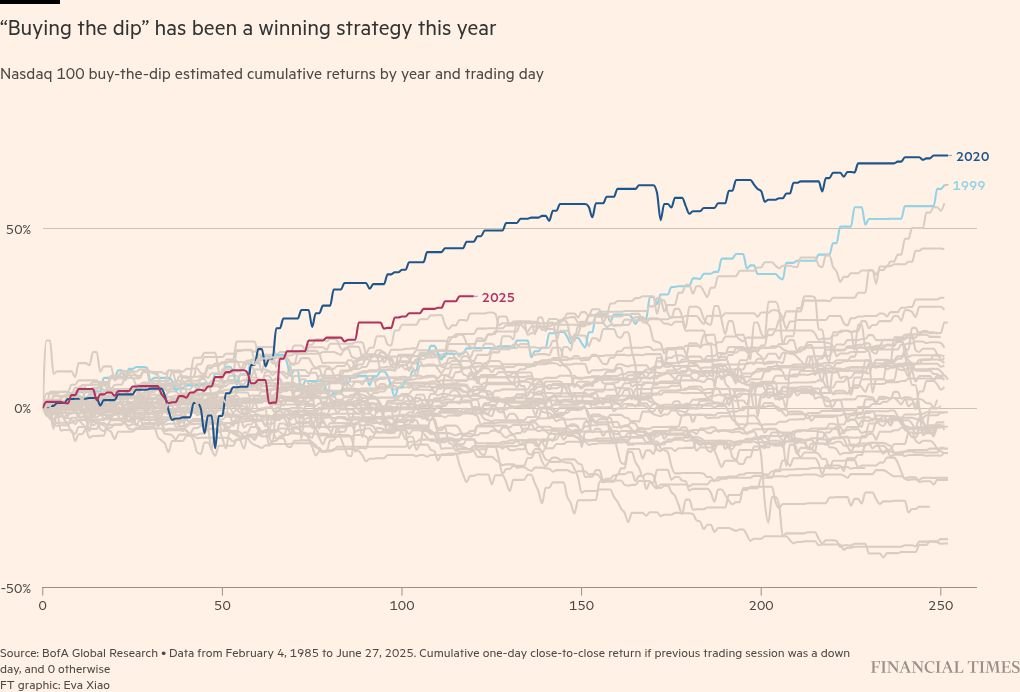While tariffs are a tangible worry for investors, something far more nefarious (and important) can weigh on the stock market.
When examined with a wide lens, no asset class has come particularly close to matching or surpassing the annualized return of stocks. But generating life-changing long-term returns in the stock market often means enduring periods of outsized volatility.
Since December, the iconic Dow Jones Industrial Average (^DJI 0.77%), benchmark S&P 500 (^GSPC 0.83%), and innovation-propelled Nasdaq Composite (^IXIC 1.02%) have been all over the map. After closing at respective record highs between December and mid-February, the Dow and S&P 500 dipped into correction territory by early April. As for the Nasdaq Composite, it entered its first bear market in three years.
Just three months later, the S&P 500 and Nasdaq Composite have achieved fresh record closing highs, with the Dow nearing an all-time high of its own.
Outsized volatility of this magnitude is typically the result of fear and uncertainty from the investing community. While it’d be easy to suggest President Donald Trump’s tariff and trade policy is Wall Street’s biggest concern, there’s actually something much more nefarious (and important) that threatens to drag down the Dow, S&P 500, and Nasdaq Composite.

President Trump delivering his State of the Union address. Image source: Official White House Photo.
President Trump’s 90-day reciprocal tariff pause is almost over
There’s no question that investors have been on edge since Trump introduced his tariff and trade policy after the close of trading on April 2. The two days following the unveiling of his tariff policy led to the S&P 500’s fifth-largest two-day percentage decline in 75 years!
Trump’s initial announcement introduced a sweeping 10% global tariff and implemented higher “reciprocal tariff” rates on dozens of countries that have historically sported adverse trade imbalances with America.
On April 9, President Trump announced a 90-day pause on reciprocal tariffs (that went into effect on April 10) for all countries except China, which allowed time for trade negotiations to take place. While some trade deals have been signed or agreed upon over the last three months, this 90-day pause is set to end on July 9, which could open up a new can of worms for the U.S. economy.
One of the issues with tariffs is the possibility of worsening trade relations with allies. Even if key trade partners are willing to accept additional tariffs, there’s the risk of anti-American sentiment in foreign countries resulting in consumers buying fewer American-made goods.
Another worry with tariffs is the potential for the domestic rate of inflation to pick up. Trump’s tariff and trade policy doesn’t do a very good job of differentiating between input and output tariffs. Whereas the latter are placed on finished products being imported into the country, input tariffs are affixed to goods used to manufacture/complete products domestically. Input tariffs threaten to reignite the U.S. inflation rate.
Further, based on a Liberty Street Economics analysis (“Do Import Tariffs Protect U.S. Firms?”) by four New York Fed economists, public companies with direct exposure to Trump’s China tariffs in 2018-2019 had worse future outcomes from 2019 to 2021 than companies with no exposure. On average, sales, profits, employment, and productivity all fell for American companies exposed to the U.S.-China trade war during Trump’s first term.
While Donald Trump’s tariffs offer a valid reason for investors to be concerned about the stock market, there’s a considerably bigger problem at hand that most investors appear to be overlooking.

Image source: Getty Images.
Is Wall Street’s rally built on a house of cards?
The stock market entered 2025 at one of its priciest valuations in history, based on the S&P 500’s Shiller price-to-earnings (P/E) ratio. In December, the Shiller P/E hit 38.89, which is the third-highest multiple during a continuous bull market when back-tested to January 1871.
The five previous instances when the Shiller P/E ratio surpassed 30 and held that multiple for at least two months were eventually (keyword!) followed by declines in the Dow, S&P 500, and/or Nasdaq Composite ranging from 20% to 89%. In other words, the stock market has a poor track record of sustaining extended valuations.
The one factor that can support premium valuations is strong growth in corporate earnings. If the publicly traded companies responsible for driving the stock market higher are delivering rock-solid earnings-per-share (EPS) growth, it may be possible to maintain aggressive valuations.
There’s just one problem: The earnings quality of these influential businesses is worse than you probably realize.
Ideally, a company’s operations should do the talking. But if you dig into the earnings reports of America’s most influential businesses, you’ll discover a number of ways profits have been (legally) bolstered by non-innovative or unsustainable methods.
For example, I regularly harp on Apple (AAPL 0.53%) as a company that’s pulled one heck of a legal smoke-and-mirrors trick on its investors. Don’t get me wrong, Apple has historically been at the leading edge of the innovative curve, and its iPhone has been the top-selling smartphone in the U.S. since introducing a 5G-capable version in the fourth quarter of 2020.
But Apple’s not-so-subtle secret to success has been its world-leading share repurchase program. Since initiating a buyback program in 2013, it has spent $775 billion to retire more than 43% of its outstanding shares.
Between fiscal 2022 and fiscal 2024 (Apple’s fiscal year ends in late September), Apple’s net income declined from $99.8 billion to $93.7 billion. However, thanks to buybacks and a lower outstanding share count, its EPS fell only from $6.11 to $6.08. It has been able to completely mask a greater than $6 billion decline in net income through buybacks and has seen its share price climb by 53% over the trailing-three-year period, as of July 2, 2025.
But this isn’t just a buyback problem masking a lack of growth. We’re also witnessing growth stocks rely on unsustainable forms of income as a significant portion of their profits.
Palantir Technologies (PLTR 1.62%) has arguably surpassed Nvidia as Wall Street’s most-revered artificial intelligence (AI) stock. Palantir’s sustainable moat, its multiyear government contracts via Gotham and predictable enterprise subscriptions from Foundry, and its 25% to 35% annual sales growth all point to its EPS growth being driven by its operations.
However, Palantir has consistently relied on interest income earned from its large cash pile to buoy its net income. During the March-ended quarter, 23% of Palantir’s $217.7 million in net income was traced back to interest income earned on its cash. This is a notable percentage of its net income coming from an unsustainable and non-innovative source — and it’s particularly egregious, given that Palantir shares are changing hands at 106 times trailing-12-month sales!
Electric-vehicle (EV) maker Tesla (TSLA 0.04%) is another perfect example of poor earnings quality in action. Ideally, Tesla’s first-mover EV advantages, along with its ongoing shift to diversify its operations into energy generation and storage, are what bolster its bottom line.
Yet, during the March-ended quarter, Tesla’s $589 million in pre-tax income derived entirely from unsustainable sources. It generated $595 million from regulatory tax credits sold to other automakers (which it receives for free from governments), as well as $309 million in net interest income, after interest expenses. If not for tax credits and net interest income, Tesla would have reported a $315 million pre-tax loss in the first quarter.
Wall Street is littered with stories similar to this, where companies have relied on unsustainable or non-innovative channels to mask a true lack of growth. With the Shiller P/E pushing to one of its priciest valuations in 154 years, poor earnings quality for America’s most influential businesses is what should really worry investors.








